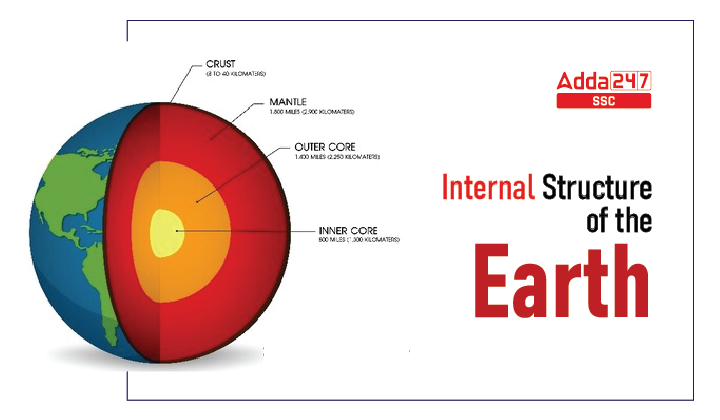The Internal Structure of the Earth is made up of several concentric layers, the most important of which are the crust, mantle, outer core, and inner core due to their distinct physical and chemical properties. The Internal Structure of the Earth can be observed using direct evidence such as deep ocean drilling projects, volcanic eruptions, rock samples from mining, and indirect evidence such as seismic waves, meteorite investigation, gravitational force, magnetic field, and so on.

Internal Structure of the Earth: Simple Diagram
A simple diagram of the internal structure of the Earth is given below:
![NCERT Notes: Structure Of Earth - Crust, Mantle, Core [Geography Notes For UPSC]](https://cdn1.byjus.com/wp-content/uploads/2018/11/free-ias-prep/2017/05/26111711/Earth_internal_structure.png)
Internal Structure of the Earth Model
The Internal Structure of the Earth is mechanically divided into the lithosphere, asthenosphere, mesospheric mantle (the part of the Earth’s mantle beneath the lithosphere and asthenosphere), outer core, and inner core but chemically, the Internal Structure of the Earth model can be divided into the crust, upper mantle, lower mantle, outer core, and inner core.
Crust
- The crust is the outermost layer of the earth.
- Density increases with depth and the average density is about 2.7 g/cm3 (the average density of the earth is 5.51 g/cm³).
- The thickness of the crust varies between 5 and 30 Kilometers for the oceanic crust and 50 and 70 Kilometers for the continental crust.
- In areas with major mountain systems, the continental crust can be thicker than 70 km. It can be up to 70-100 km thick in the Himalayas.
- The temperature of the crust increases with depth, reaching values typically in the range from about 200 °C to 400 °C at the boundary with the underlying mantle.
- The temperature increases by as much as 30 °C for every Kilometre in the upper part of the crust.
- The outer covering of the crust is of sedimentary material and below that lie crystalline, igneous and metamorphic rocks which are acidic.
- The lower layer of the crust consists of basaltic rocks.
- The continents are composed of lighter silicates — silica + Aluminium (also called SIAL) like granite, while the oceans have heavier silicates — silica + Magnesium (also called SIMA) like basalt.
- Sometimes SIAL is used to refer to the Lithosphere, which is the region comprising the crust and uppermost solid mantle. The lithosphere is broken into tectonic plates (lithospheric plates), and the movement of these tectonic plates causes large-scale changes in the earth’s geological structure (folding, faulting).
- The discontinuity between the hydrosphere and crust is termed the Conrad Discontinuity.
Mantle
- The portion of the interior beyond the crust is called the mantle. It forms about 83 percent of the earth’s volume.
- The discontinuity between the crust and mantle is called as the Mohorovich Discontinuity or Moho discontinuity.
- The mantle is composed of silicate rocks that are rich in iron and magnesium.
- The upper portion of the mantle is called the asthenosphere. It lies just below the lithosphere extending up to 80-200 km. It is highly viscous, mechanically weak, and ductile and its density is higher than that of the crust. These properties of the asthenosphere aid in plate tectonic movement and isostatic adjustments. It is the main source of magma that finds its way to the surface during volcanic eruptions.
- The mantle is made up of 45% oxygen, 21% silicon, and 23% magnesium (OSM).
- In the mantle, temperatures range from approximately 200 °C at the upper boundary with the crust to approximately 4,000 °C at the core-mantle boundary.
- Because of the temperature difference, there is a convective material circulation in the mantle (although solid, the high temperatures within the mantle cause the silicate material to be sufficiently ductile).
- Gutenberg Discontinuity lies between the mantle and the outer core
Outer Core
- The outer core, which surrounds the inner core, is located between 2900 and 5100 kilometers below the earth’s surface.
- The outer core is made up of iron mixed with nickel (nife).
- The outer core is not under enough pressure to be solid, so it is liquid even though it has a composition similar to the inner core.
- The temperature of the outer core ranges from 4400 degrees Celsius in the outer regions to 6000 degrees Celsius near the inner core.
- According to dynamo theory, the Earth’s magnetic field is created by convection in the outer core combined with the Coriolis effect.
Inner Core
- The inner core extends from the center of the earth to 5100 km below the earth’s surface.
- The inner core is composed of iron and some nickel.
- The inner core is in a solid state and the outer core is in a liquid state (or semi-liquid).
- Earth’s inner core rotates slightly faster relative to the rotation of the surface.
- The solid inner core is too hot to sustain a magnetic field.
- This iron core is as hot as the Sun’s surface at 6000°C, but gravity’s crushing pressure prevents it from becoming liquid.
Questions Asked on the Internal Structure of the Earth
The topic of the ‘Internal Structure of the Earth’ is the source of many questions that can be asked in the various competitive exams. As it is one of the fundamental concepts in the subject of Geography, it gives rise to many types of questions. Some of the questions asked in various exams on this topic have been provided below for the reference of the candidates.
Q. What is the Lithosphere?
Ans. The crust and the uppermost part of the mantle make up the lithosphere. Above the lithosphere is the atmosphere and below it is the asthenosphere. The average thickness of the lithosphere spans from 10 to 200 km. The term lithosphere comes from the root ‘Litho’ which means ‘Stone’.
Q. What is the difference between SIAL, SIMA and NIFE?
Ans. SIAL stands for Silicon and Aluminium and is found on the continental crust. SIMA stands for Silicon and Magnesium and is found in the oceanic crust and NIFE stands for Nickel and Iron (Fe) and is found in the core of the earth.
Q. How do we know about the internal structure of the earth?
Ans. The seismic waves that travel inside the earth during earthquakes experience different velocities in different mediums. The analysis of this data provides the geologists with an idea about the various types of materials inside the earth and over time, it leads to an overall understanding of the structure.
Q. What is the structure and properties of Earth’s interior?
Ans. The structure consists of an outer silicate solid crust, a highly viscous asthenosphere, and solid mantle, a liquid outer core whose flow generates the Earth’s magnetic field, and a solid inner core.




 Reasoning Topics Asked in SSC CGL Exam L...
Reasoning Topics Asked in SSC CGL Exam L...
 Top 10 Longest Rivers in India, Largest ...
Top 10 Longest Rivers in India, Largest ...
 Mughal Empire Notes For RRB NTPC Exam 20...
Mughal Empire Notes For RRB NTPC Exam 20...


